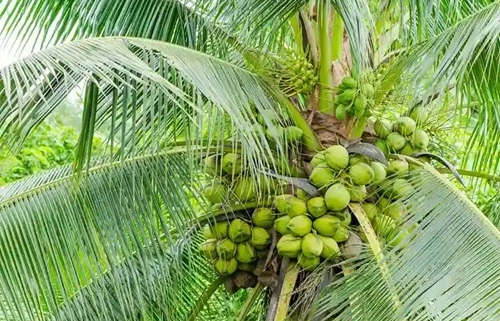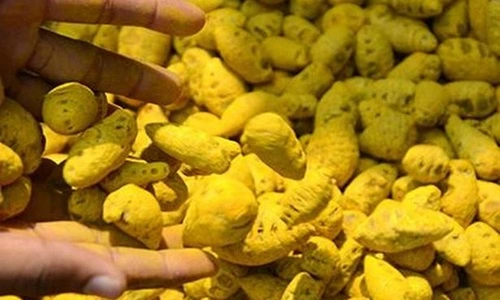Coconut is one of the most significant crops in India, often referred to as the “Tree of Life” due to its multiple uses, from food and oil to fiber and timber. India is the largest producer of coconuts globally, contributing significantly to the economy and livelihoods, particularly in states like Kerala, Tamil Nadu, Karnataka, Andhra Pradesh, Goa, West Bengal, and Maharashtra.
Coconut varieties are classified into tall, dwarf, and hybrid types, each serving different purposes such as tender coconut water, oil production, copra (dried kernel), and coir fiber extraction. Selecting the right variety based on purpose and regional suitability is key to achieving high yields and profitability.
This article highlights more than 10 top coconut varieties in India, their characteristics, cultivation regions, and uses.

1. East Coast Tall (ECT)
East Coast Tall is one of the most commonly cultivated tall varieties in India, known for its high copra yield and oil content.
- Type: Tall
- Nut Size: Medium to large
- Copra Yield: 160–180 grams per nut
- Oil Content: 65–68%
- Regions: Tamil Nadu, Andhra Pradesh, Karnataka
- Characteristics:
- Begins bearing fruit at 6–8 years
- Long productive life of up to 60 years
- High drought tolerance
- Uses: Oil extraction, copra production
2. West Coast Tall (WCT)
West Coast Tall is another widely grown tall variety, highly adaptable to different climates and soil types.
- Type: Tall
- Nut Size: Large
- Copra Yield: 150–170 grams per nut
- Oil Content: 65–70%
- Regions: Kerala, Karnataka, Goa
- Characteristics:
- Begins fruiting at 6–7 years
- Long lifespan with consistent productivity
- Uses: Copra, coconut oil, coir production
3. Chowghat Orange Dwarf (COD)
Chowghat Orange Dwarf is a popular dwarf variety known for its tender coconut water and high nut production.
- Type: Dwarf
- Nut Size: Medium
- Water Content: 250–300 ml per nut
- Regions: Kerala, Tamil Nadu, Karnataka
- Characteristics:
- Begins bearing fruit in 3–4 years
- Produces vibrant orange nuts
- Ideal for tender coconut markets
- Uses: Tender coconut water, ornamental purposes
4. Malayan Yellow Dwarf (MYD)
MYD is a dwarf variety highly valued for its tender coconut water and early fruit-bearing capacity.
- Type: Dwarf
- Nut Size: Small to medium
- Water Content: 300–350 ml per nut
- Regions: Tamil Nadu, Kerala, Maharashtra
- Characteristics:
- Early maturity, starts yielding in 3–4 years
- High productivity with yellow-colored nuts
- Uses: Tender coconut water, small-scale copra production
5. Malayan Green Dwarf (MGD)
Malayan Green Dwarf is another variety of the Malayan family, known for its sweet coconut water and green husk color.
- Type: Dwarf
- Nut Size: Small to medium
- Water Content: 300–350 ml per nut
- Regions: Kerala, Karnataka, Tamil Nadu
- Characteristics:
- Early fruit-bearing (3–4 years)
- Suitable for tender coconut markets
- Uses: Tender coconut water, home gardens
6. Lakshadweep Ordinary (LO)
Lakshadweep Ordinary is a traditional tall variety known for its adaptability to saline soils and coastal climates.
- Type: Tall
- Nut Size: Medium
- Oil Content: 65–68%
- Regions: Lakshadweep Islands, Kerala, coastal areas
- Characteristics:
- High salt tolerance
- Moderate copra yield with good oil recovery
- Uses: Oil extraction, copra production
7. Kalpa Sree (Hybrid)
Kalpa Sree is a high-yielding hybrid variety developed by the Central Plantation Crops Research Institute (CPCRI).
- Type: Hybrid (Tall x Dwarf)
- Nut Size: Medium
- Copra Yield: 190–210 grams per nut
- Oil Content: 68–70%
- Regions: Kerala, Tamil Nadu, Karnataka
- Characteristics:
- High yield and early fruit-bearing (4–5 years)
- Resistant to pests and diseases
- Uses: Copra production, oil extraction
8. Kalpa Raksha (Hybrid)
Kalpa Raksha is a hybrid variety developed for its high drought tolerance and high copra yield.
- Type: Hybrid (Tall x Tall)
- Nut Size: Large
- Copra Yield: 200–220 grams per nut
- Oil Content: 68–72%
- Regions: Andhra Pradesh, Tamil Nadu, Karnataka
- Characteristics:
- Drought-resistant and high productivity
- Early fruit-bearing (4–5 years)
- Uses: Oil production, copra
9. Gangabondam (Tall)
Gangabondam is a tall variety suitable for both copra and tender coconut production.
- Type: Tall
- Nut Size: Medium to large
- Water Content: 200–300 ml per nut
- Regions: Andhra Pradesh, Tamil Nadu
- Characteristics:
- Dual-purpose (tender coconut and copra)
- High productivity with consistent yield
- Uses: Tender coconut water, copra
10. Chandra Kalpa
Chandra Kalpa is a hybrid variety suitable for high copra and oil yield.
- Type: Hybrid
- Nut Size: Medium to large
- Copra Yield: 190–210 grams per nut
- Oil Content: 70%
- Regions: Kerala, Karnataka
- Characteristics:
- Early fruit-bearing (4–5 years)
- High copra recovery rate
- Uses: Oil extraction, copra production
FAQs
Q1: Which coconut variety is best for tender coconut water?
A: Chowghat Orange Dwarf (COD), Malayan Yellow Dwarf (MYD), and Malayan Green Dwarf (MGD) are ideal for tender coconut production.
Q2: Which coconut variety has the highest oil content?
A: Kalpa Sree, Chandra Kalpa, and West Coast Tall have high oil content ranging from 68% to 72%.
Q3: What is the difference between tall and dwarf coconut varieties?
A: Tall varieties have a longer lifespan and are used for copra and oil production, while dwarf varieties bear fruit early and are best for tender coconut water.
Q4: Which hybrid coconut varieties are recommended for commercial cultivation?
A: Kalpa Sree, Kalpa Raksha, and Chandra Kalpa are excellent hybrid varieties for high yield and oil production.
Q5: Which states are the leading producers of coconuts in India?
A: Kerala, Tamil Nadu, Karnataka, Andhra Pradesh, and Goa are the top coconut-producing states in India.
Conclusion
India’s diverse agro-climatic regions and advancements in agricultural research have led to the development of various high-yielding, disease-resistant, and versatile coconut varieties. From tall varieties like East Coast Tall to hybrids like Kalpa Sree, farmers can select suitable varieties based on their goals, whether for copra production, oil extraction, or tender coconut markets. By adopting the right variety and improved cultivation practices, coconut farming can offer sustainable and profitable returns.

